Tianxin Wei
Panda: Test-Time Adaptation with Negative Data Augmentation
Nov 13, 2025Abstract:Pretrained VLMs exhibit strong zero-shot classification capabilities, but their predictions degrade significantly under common image corruptions. To improve robustness, many test-time adaptation (TTA) methods adopt positive data augmentation (PDA), which generates multiple views of each test sample to reduce prediction variance. However, these methods suffer from two key limitations. First, it introduces considerable computational overhead due to the large number of augmentations required per image. Second, it fails to mitigate prediction bias, where the model tends to predict certain classes disproportionately under corruption, as PDA operates on corrupted inputs and typically does not remove the corruption itself. To address these challenges, we propose Panda, a novel TTA method based on negative data augmentation (NDA). Unlike positive augmentations that preserve object semantics, Panda generates negative augmentations by disrupting semantic content. It divides images into patches and randomly assembles them from a shared patch pool. These negatively augmented images retain corruption-specific features while discarding object-relevant signals. We then subtract the mean feature of these negative samples from the original image feature, effectively suppressing corruption-related components while preserving class-relevant information. This mitigates prediction bias under distribution shifts. Panda allows augmentation to be shared across samples within a batch, resulting in minimal computational overhead. Panda can be seamlessly integrated into existing test-time adaptation frameworks and substantially improve their robustness. Our experiments indicate that Panda delivers superior performance compared to PDA methods, and a wide range of TTA methods exhibit significantly enhanced performance when integrated with Panda. Our code is available at https://github.com/ruxideng/Panda .
NIRVANA: Structured pruning reimagined for large language models compression
Sep 17, 2025Abstract:Structured pruning of large language models (LLMs) offers substantial efficiency improvements by removing entire hidden units, yet current approaches often suffer from significant performance degradation, particularly in zero-shot settings, and necessitate costly recovery techniques such as supervised fine-tuning (SFT) or adapter insertion. To address these critical shortcomings, we introduce NIRVANA, a novel pruning method explicitly designed to balance immediate zero-shot accuracy preservation with robust fine-tuning capability. Leveraging a first-order saliency criterion derived from the Neural Tangent Kernel under Adam optimization dynamics, NIRVANA provides a theoretically grounded pruning strategy that respects essential model training behaviors. To further address the unique challenges posed by structured pruning, NIRVANA incorporates an adaptive sparsity allocation mechanism across layers and modules (attention vs. MLP), which adjusts pruning intensity between modules in a globally balanced manner. Additionally, to mitigate the high sensitivity of pruning decisions to calibration data quality, we propose a simple yet effective KL divergence-based calibration data selection strategy, ensuring more reliable and task-agnostic pruning outcomes. Comprehensive experiments conducted on Llama3, Qwen, and T5 models demonstrate that NIRVANA outperforms existing structured pruning methods under equivalent sparsity constraints, providing a theoretically sound and practical approach to LLM compression. The code is available at https://github.com/iDEA-iSAIL-Lab-UIUC/NIRVANA.
Flow Matching Meets Biology and Life Science: A Survey
Jul 23, 2025Abstract:Over the past decade, advances in generative modeling, such as generative adversarial networks, masked autoencoders, and diffusion models, have significantly transformed biological research and discovery, enabling breakthroughs in molecule design, protein generation, drug discovery, and beyond. At the same time, biological applications have served as valuable testbeds for evaluating the capabilities of generative models. Recently, flow matching has emerged as a powerful and efficient alternative to diffusion-based generative modeling, with growing interest in its application to problems in biology and life sciences. This paper presents the first comprehensive survey of recent developments in flow matching and its applications in biological domains. We begin by systematically reviewing the foundations and variants of flow matching, and then categorize its applications into three major areas: biological sequence modeling, molecule generation and design, and peptide and protein generation. For each, we provide an in-depth review of recent progress. We also summarize commonly used datasets and software tools, and conclude with a discussion of potential future directions. The corresponding curated resources are available at https://github.com/Violet24K/Awesome-Flow-Matching-Meets-Biology.
Saffron-1: Towards an Inference Scaling Paradigm for LLM Safety Assurance
Jun 06, 2025Abstract:Existing safety assurance research has primarily focused on training-phase alignment to instill safe behaviors into LLMs. However, recent studies have exposed these methods' susceptibility to diverse jailbreak attacks. Concurrently, inference scaling has significantly advanced LLM reasoning capabilities but remains unexplored in the context of safety assurance. Addressing this gap, our work pioneers inference scaling for robust and effective LLM safety against emerging threats. We reveal that conventional inference scaling techniques, despite their success in reasoning tasks, perform poorly in safety contexts, even falling short of basic approaches like Best-of-N Sampling. We attribute this inefficiency to a newly identified challenge, the exploration--efficiency dilemma, arising from the high computational overhead associated with frequent process reward model (PRM) evaluations. To overcome this dilemma, we propose SAFFRON, a novel inference scaling paradigm tailored explicitly for safety assurance. Central to our approach is the introduction of a multifurcation reward model (MRM) that significantly reduces the required number of reward model evaluations. To operationalize this paradigm, we further propose: (i) a partial supervision training objective for MRM, (ii) a conservative exploration constraint to prevent out-of-distribution explorations, and (iii) a Trie-based key--value caching strategy that facilitates cache sharing across sequences during tree search. Extensive experiments validate the effectiveness of our method. Additionally, we publicly release our trained multifurcation reward model (Saffron-1) and the accompanying token-level safety reward dataset (Safety4M) to accelerate future research in LLM safety. Our code, model, and data are publicly available at https://github.com/q-rz/saffron , and our project homepage is at https://q-rz.github.io/p/saffron .
Breaking Silos: Adaptive Model Fusion Unlocks Better Time Series Forecasting
May 24, 2025Abstract:Time-series forecasting plays a critical role in many real-world applications. Although increasingly powerful models have been developed and achieved superior results on benchmark datasets, through a fine-grained sample-level inspection, we find that (i) no single model consistently outperforms others across different test samples, but instead (ii) each model excels in specific cases. These findings prompt us to explore how to adaptively leverage the distinct strengths of various forecasting models for different samples. We introduce TimeFuse, a framework for collective time-series forecasting with sample-level adaptive fusion of heterogeneous models. TimeFuse utilizes meta-features to characterize input time series and trains a learnable fusor to predict optimal model fusion weights for any given input. The fusor can leverage samples from diverse datasets for joint training, allowing it to adapt to a wide variety of temporal patterns and thus generalize to new inputs, even from unseen datasets. Extensive experiments demonstrate the effectiveness of TimeFuse in various long-/short-term forecasting tasks, achieving near-universal improvement over the state-of-the-art individual models. Code is available at https://github.com/ZhiningLiu1998/TimeFuse.
CLIMB: Class-imbalanced Learning Benchmark on Tabular Data
May 23, 2025Abstract:Class-imbalanced learning (CIL) on tabular data is important in many real-world applications where the minority class holds the critical but rare outcomes. In this paper, we present CLIMB, a comprehensive benchmark for class-imbalanced learning on tabular data. CLIMB includes 73 real-world datasets across diverse domains and imbalance levels, along with unified implementations of 29 representative CIL algorithms. Built on a high-quality open-source Python package with unified API designs, detailed documentation, and rigorous code quality controls, CLIMB supports easy implementation and comparison between different CIL algorithms. Through extensive experiments, we provide practical insights on method accuracy and efficiency, highlighting the limitations of naive rebalancing, the effectiveness of ensembles, and the importance of data quality. Our code, documentation, and examples are available at https://github.com/ZhiningLiu1998/imbalanced-ensemble.
Pave Your Own Path: Graph Gradual Domain Adaptation on Fused Gromov-Wasserstein Geodesics
May 19, 2025

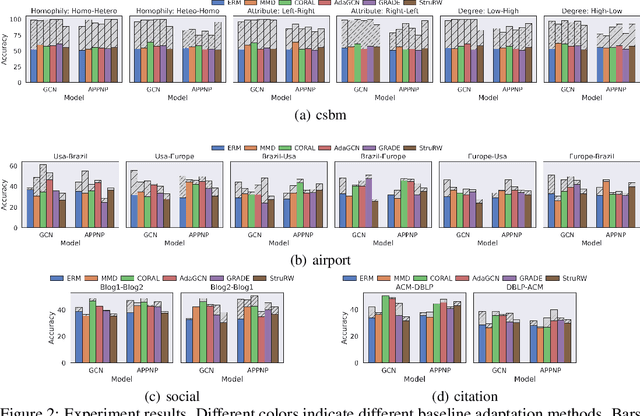
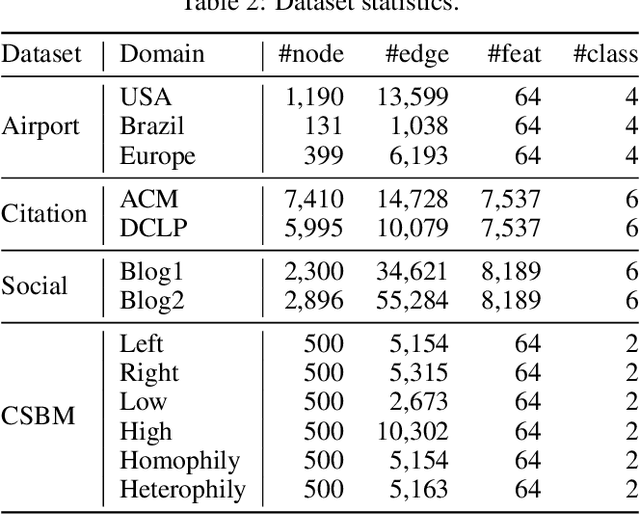
Abstract:Graph neural networks, despite their impressive performance, are highly vulnerable to distribution shifts on graphs. Existing graph domain adaptation (graph DA) methods often implicitly assume a \textit{mild} shift between source and target graphs, limiting their applicability to real-world scenarios with \textit{large} shifts. Gradual domain adaptation (GDA) has emerged as a promising approach for addressing large shifts by gradually adapting the source model to the target domain via a path of unlabeled intermediate domains. Existing GDA methods exclusively focus on independent and identically distributed (IID) data with a predefined path, leaving their extension to \textit{non-IID graphs without a given path} an open challenge. To bridge this gap, we present Gadget, the first GDA framework for non-IID graph data. First (\textit{theoretical foundation}), the Fused Gromov-Wasserstein (FGW) distance is adopted as the domain discrepancy for non-IID graphs, based on which, we derive an error bound revealing that the target domain error is proportional to the length of the path. Second (\textit{optimal path}), guided by the error bound, we identify the FGW geodesic as the optimal path, which can be efficiently generated by our proposed algorithm. The generated path can be seamlessly integrated with existing graph DA methods to handle large shifts on graphs, improving state-of-the-art graph DA methods by up to 6.8\% in node classification accuracy on real-world datasets.
CATS: Mitigating Correlation Shift for Multivariate Time Series Classification
Apr 05, 2025Abstract:Unsupervised Domain Adaptation (UDA) leverages labeled source data to train models for unlabeled target data. Given the prevalence of multivariate time series (MTS) data across various domains, the UDA task for MTS classification has emerged as a critical challenge. However, for MTS data, correlations between variables often vary across domains, whereas most existing UDA works for MTS classification have overlooked this essential characteristic. To bridge this gap, we introduce a novel domain shift, {\em correlation shift}, measuring domain differences in multivariate correlation. To mitigate correlation shift, we propose a scalable and parameter-efficient \underline{C}orrelation \underline{A}dapter for M\underline{TS} (CATS). Designed as a plug-and-play technique compatible with various Transformer variants, CATS employs temporal convolution to capture local temporal patterns and a graph attention module to model the changing multivariate correlation. The adapter reweights the target correlations to align the source correlations with a theoretically guaranteed precision. A correlation alignment loss is further proposed to mitigate correlation shift, bypassing the alignment challenge from the non-i.i.d. nature of MTS data. Extensive experiments on four real-world datasets demonstrate that (1) compared with vanilla Transformer-based models, CATS increases over $10\%$ average accuracy while only adding around $1\%$ parameters, and (2) all Transformer variants equipped with CATS either reach or surpass state-of-the-art baselines.
ResMoE: Space-efficient Compression of Mixture of Experts LLMs via Residual Restoration
Mar 10, 2025Abstract:Mixture-of-Experts (MoE) Transformer, the backbone architecture of multiple phenomenal language models, leverages sparsity by activating only a fraction of model parameters for each input token. The sparse structure, while allowing constant time costs, results in space inefficiency: we still need to load all the model parameters during inference. We introduce ResMoE, an innovative MoE approximation framework that utilizes Wasserstein barycenter to extract a common expert (barycenter expert) and approximate the residuals between this barycenter expert and the original ones. ResMoE enhances the space efficiency for inference of large-scale MoE Transformers in a one-shot and data-agnostic manner without retraining while maintaining minimal accuracy loss, thereby paving the way for broader accessibility to large language models. We demonstrate the effectiveness of ResMoE through extensive experiments on Switch Transformer, Mixtral, and DeepSeekMoE models. The results show that ResMoE can reduce the number of parameters in an expert by up to 75% while maintaining comparable performance. The code is available at https://github.com/iDEA-iSAIL-Lab-UIUC/ResMoE.
SelfElicit: Your Language Model Secretly Knows Where is the Relevant Evidence
Feb 12, 2025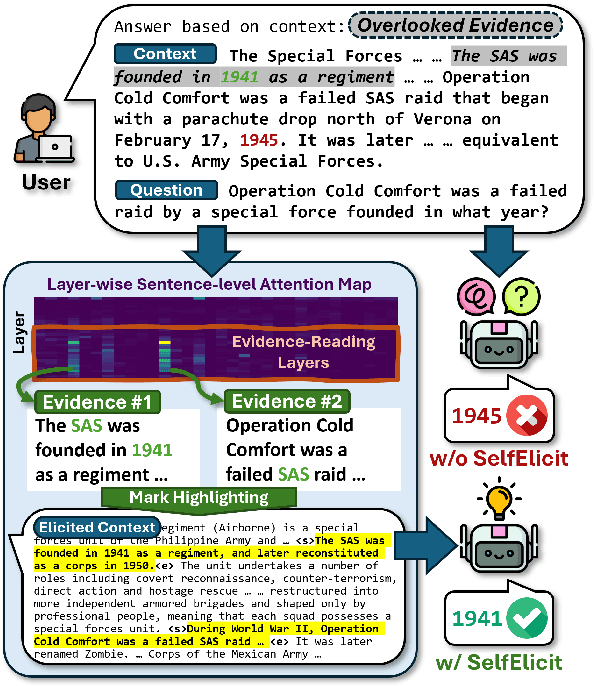
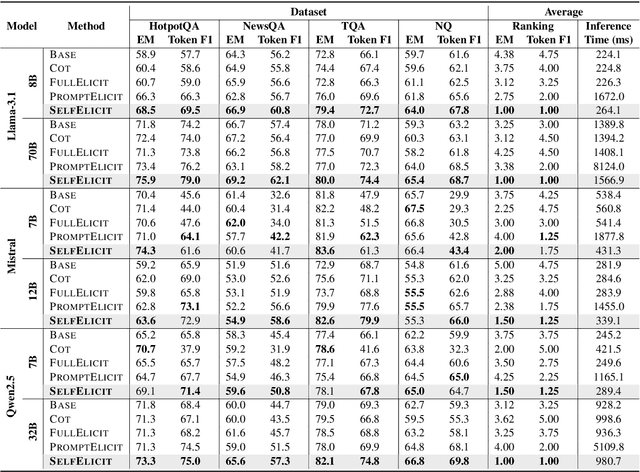

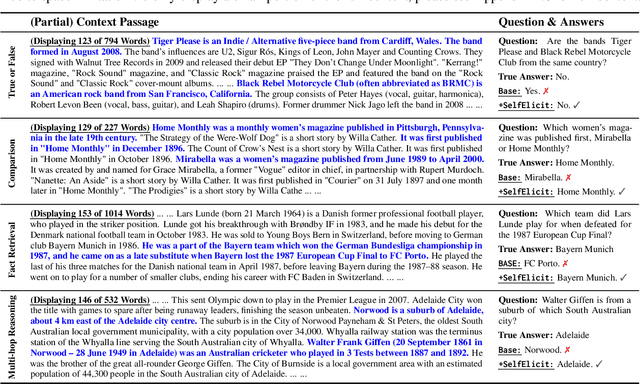
Abstract:Providing Language Models (LMs) with relevant evidence in the context (either via retrieval or user-provided) can significantly improve their ability to provide factually correct grounded responses. However, recent studies have found that LMs often struggle to fully comprehend and utilize key evidence from the context, especially when it contains noise and irrelevant information - an issue common in real-world scenarios. To address this, we propose SelfElicit, an inference-time approach that helps LMs focus on key contextual evidence through self-guided explicit highlighting. By leveraging the inherent evidence-finding capabilities of LMs using the attention scores of deeper layers, our method automatically identifies and emphasizes key evidence within the input context, facilitating more accurate and factually grounded responses without additional training or iterative prompting. We demonstrate that SelfElicit brings consistent and significant improvement on multiple evidence-based QA tasks for various LM families while maintaining computational efficiency. Our code and documentation are available at https://github.com/ZhiningLiu1998/SelfElicit.
 Add to Chrome
Add to Chrome Add to Firefox
Add to Firefox Add to Edge
Add to Edge